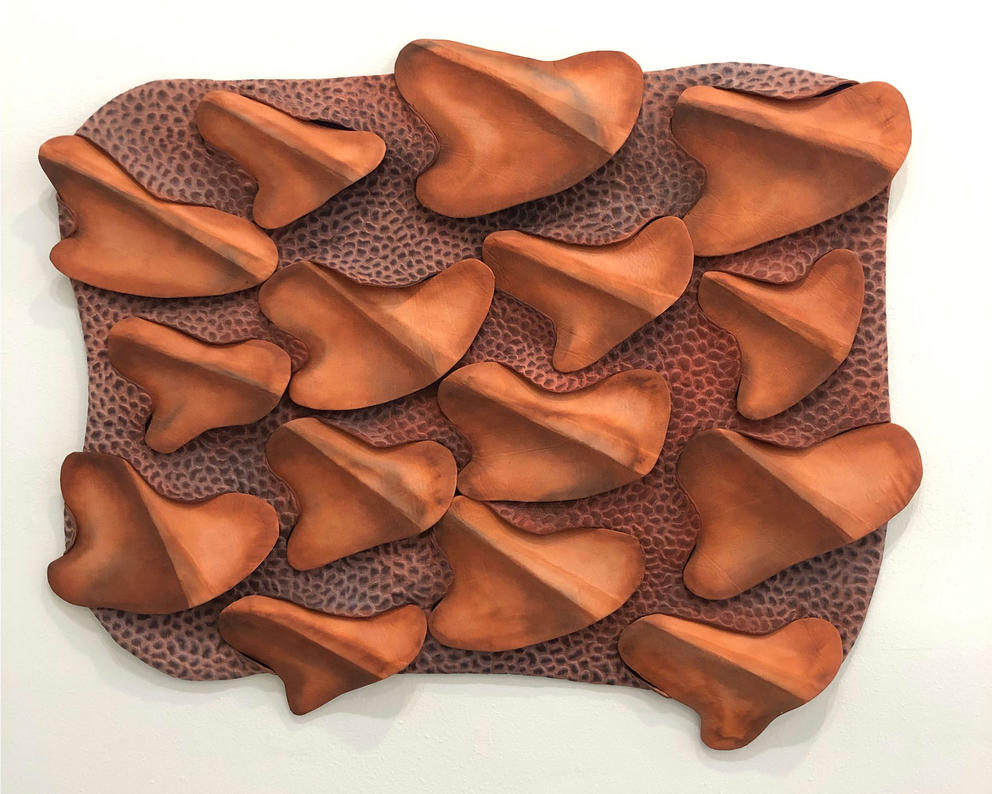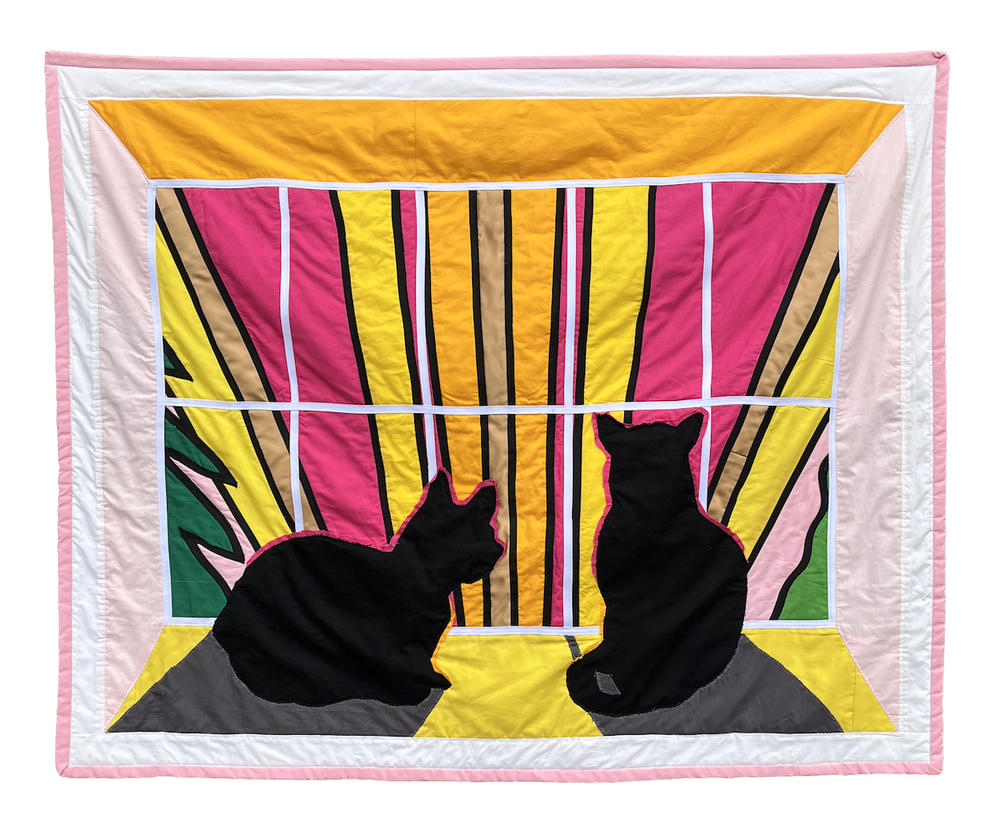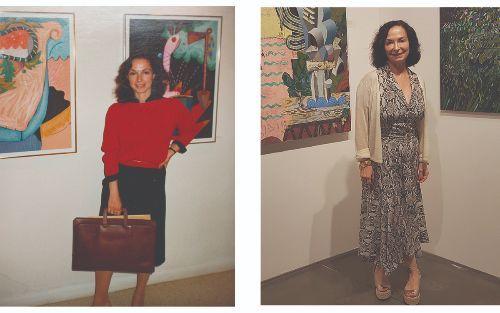As McClusky noted during the preview, the prevalence of fast fashion and other factory-made fabrics means we rarely give cloth-making much consideration at all.
That’s not the case at Ikat (through May 29), where textile arts from nine different parts of the world — and across several centuries — celebrate a kind of “slow fashion,” with careful thought woven into each design element.
I never really understood how ikat patterns were made, especially as distinct from popular faux ikat fabrics, in which repeated blurry shapes are printed on a background to create a pattern. But real ikat is a painstaking process of selecting specific threads and tying them off, so they “resist” the dye applied overall.
The process clicked for me in the incredibly colorful exhibit’s ocean-blue gallery, dedicated to Indonesian ikat, where samples of the cloth-binding process offer a revealing look behind the scenes of creation.
ArtSEA: Notes on Northwest Culture is Crosscut’s weekly arts & culture newsletter.
There are so many gorgeous garments and wall hangings here: indigo kimonos from Japan and multipatterned robes from Nigeria; astonishing cloth artworks from India, Uzbekistan and the Americas.
The textiles seem to call out for tactile engagement, but steer clear. SAM has designed a clever way to protect the fabrics from unwanted handling — a wooden floor fence resembling a xylophone — which I saw several people at the press preview stumble into in their desire to get close.
There is in fact a lot of compelling cloth on the walls of local galleries right now. At Vestibule Gallery in Ballard, the new exhibit Wall Hanging (May 18 - June 10; artists’ reception May 20) is a group show of contemporary and experimental textile and fiber arts that explore and explode quilting, tufting and tapestry.
Included in the playful mix is Northwest artist Deborah Kapoor’s huge wall sculpture “Dervish,” made from repurposed family saris, as well as digital loom tapestries by Seattle’s Allyce Wood. One of the most compelling works of cloth here is a piece by Carla Stehr, a former marine biologist who uses microscopic views of marine life as inspiration for her three-dimensional quilts.
Based on the skin of a Puget Sound pacific spiny dogfish — as seen via electron microscope — Stehr’s “Denticles” quilt replicates the tiny toothlike structures that make a shark’s skin feel rough if rubbed the wrong way. (Do not rub a shark the wrong way.) In the quilt, the denticles are made of interfacing material and hand-painted batik fabric. The result is like no textile I’ve ever seen. Very strange + scientific = compelling cloth.
At Greg Kucera Gallery in Pioneer Square, Bremerton-based artist Joey Veltkamp is showing new works in his series of real-life inspired “soft sculptures” (sewn wall hangings that aren’t quite quilts).
Tell Your Cat I Said PSPSPS (May 18 - July 1; artist reception June 1) is highly influenced by Veltkamp’s recent acquisition of five stray cats, to whom he pays homage in endearing fabric silhouettes. Also in the mix are bunches of pretty fabric flowers — because, as Veltkamp said on Instagram, he can’t bring real flora indoors anymore due to those darn cats.
If you’ve caught fabric fever take note: You still have time to catch the current show at the Lightcatcher Museum in Bellingham. Katazome Today: Migrations of a Japanese Art (through June 11) showcases contemporary uses of a historic textile-dyeing process that involves a rice-paste resist (compare to ikat above) and hand-stenciled papers. With subject matter from snow geese to McDonald’s cast-offs to the women of the U.S. Congress, these fresh applications of the form are surprising and lovely.
And at Method Gallery in Pioneer Square, Seattle artist Megan Prince is showing Red Ratchet Strap Remnant Relationship (RRSRR) (June 1 - July 6), a very large, blobular hanging piece woven from 12,000 feet of used red straps (donated by local artist collective Sutton Beres Culler).
A weaver with an environmental bent, Prince often sources cast-offs from her surrounding community to make her soft sculptures — and was recently spotted on Instagram seeking old jeans of all colors for a new “Rainbow Jean Body” in progress. Compelling! Cloth!
We’ll end this week’s newsletter with a longtime local curator who’s hanging up the art of hanging art. Linda Hodges, who has run her own gallery in Pioneer Square since 1983 (starting as the Hodges/Banks Gallery, with Yvonne Banks), is closing up shop.
When I spoke with her on the phone earlier this week, Hodges, 75, told me the timing “just feels right,” adding that galleries have a lifespan, “a natural evolution.” The first show she featured was work by local multimedia artist Jack Chevalier, in 1983. The last will feature Northwest painter Gaylen Hansen, currently 101 years old, who is acclaimed for his golden-toned and humor-edged Palouse scenes (June 1 - 30).
Originally from New York City, Hodges moved to Seattle in 1976 and has always had an eye for art. After starting out as an art consultant in 1980, she went on to run her own gallery: “12 shows a year for 40 years,” she marveled. Hodges said she still has newspaper clippings from all the show reviews, “for my memoirs,” she joked.
As for the state of Seattle art galleries, Hodges said she’s leaving on a high note, with a strong contingent of newer spaces in the mix. “I’m very optimistic for this town,” she said. “It’s still a boom town — oh, and I’m so glad the Cinerama is back!”
As for what she’ll do in retirement, Hodges mentioned travel and spending time with family, and maybe something novel for a gallery owner: “I might go out for First Thursday art walk.”
Get the latest in local arts and culture
This weekly newsletter brings arts news and cultural events straight to your inbox.





